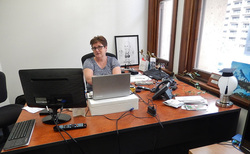
I'm talking about sitting at a desk all day.
If you're anything like me, you are in front of a computer for 8+ hours on a regular work day. While a few offices have recently enacted standing or walking desks for their employees, they are by far the minority. And most people, after sitting at a desk all day, then come home and sit in front of the TV for several hours.
You may think the only harm this is doing to you is an aching back and a stiff neck, but researchers are finding this isn't the case. In fact, sitting for long periods of time - as so many of us do in today's modern world - is linked to all kinds of diseases and health problems. There's even a popular new term being used to describe this phenomenon; it's called "sitting disease."
If you're one of those people who has a desk job, you are at high risk for sitting disease. Read on to find out why this is so bad for your health, and what you can do about it....
This research is backed up by a large study of 240,000 adults ages 50 to 71 conducted by the National Cancer Institute, which found that "People who were sedentary for more than 7 hours a day – even if they exercised every day – had a 61% higher risk of dying from cardiovascular disease, and a 22% higher risk of dying from cancer compared to those who were sedentary for less than an hour."
For those who don't exercise, the news is even worse. Those who didn't exercise regularly in this study had a 47% higher risk of death from all causes, and a 100% greater chance of dying of cardiovascular disease. (Source: Am J Clin Nutr. 2012;95(2):437-45.)
This may seem pretty depressing. After all, if you have a job where you are required to sit at a desk for 8 hours every day, what is a person to do? Quit your job and become a farmer or manual laborer? But actually, if you read between the lines of these studies, you'll find some hope. In fact, when you look at the numbers, what this also shows is that those who exercise regularly are 30% less likely to die of any cause than those who get little or no exercise - even if you do spend most of your day sitting.
Not only that, but getting up and getting moving frequently helps burn calories, boost metabolism, and prevent back pain and other pain conditions. (For more on the health benefits of incorporating even small amounts of regular movement into your day, check out James Levine, M.D.'s excellent book, Move a Little, Lose a Lot.)
For me, with my chronic back issues, sitting is a major problem. However, I've found it really does help to get up and move around for a few minutes - the more often, the better, but I try to do it at least every hour. When I'm in the middle of an active pain episode, I have to do it at least every half hour. The hard part is remembering to/making myself do it! But whenever I don't, I usually end up paying for it, so I've gotten better about it over the years.
| In fact, it's time for me to get up and take a stretch break right now.... I'll be back in a few minutes.... Okay I'm back! (Moved some boxes and changed a light bulb.) Anyway, as I was saying, breaking up your sitting with short periods of movement can really help avoid chronic muscle tightness and associated pain. I try to take a short break about every 45 minutes - a quick walk and stretch, for example, and a longer break (5-10 minutes) every couple of hours, preferably one that involves a variety of movements that are quite different than what you would do sitting at a computer. |
I have a series of stretching/strengthening exercises for my back that I do behind my desk, and there are lots of different things you may be able to do at work, depending on your situation. (Pushups, wall stretches, Downward Facing Dog, hamstring and hip stretches, etc.) Some stretches and exercises you can even do from your chair, and while these may help at least break your body out of its regular patterns and relieve stiffness, I find it is best to get up out of your chair as much as possible.
A few suggestions that Dr. Levine gives include taking walking meetings, standing up whenever you're on the phone if possible, and requesting or purchasing a standing desk (or even better a treadmill desk) for your office. Not only will this help prevent pain, but as mentioned above, it can help reduce your risk of an unhealthy life and an early death.
Your body was made to move - pretty much constantly. Today's modern sedentary lifestyle is taking its toll - in more ways than one. While some people, like me, have learned to manage or live with a certain amount of chronic pain, others suffer the consequences through weight gain, high blood pressure, diabetes, and more. Don't let sitting disease get the best of you!
Make a commitment now, that no matter what you're doing, you will get up from your chair and walk around at least once every hour. Even better, try Levine's approach to incorporating more movement into all of your daily activities. Check out our exercise page and blog for more fast, fun ways to exercise. And if you're pressed for time (and who isn't), try one of the new high-intensity workout programs that only take a few minutes per day, such as P.A.C.E. Express.
While these steps can't completely reverse the effects of sitting for most of the day, they can definitely help improve your health, your longevity, and your enjoyment of life!
To your health,
Rose.
P.S. Want more? Subscribe to our weekly updates below!




 RSS Feed
RSS Feed